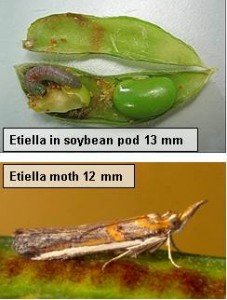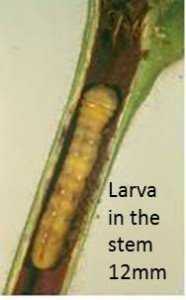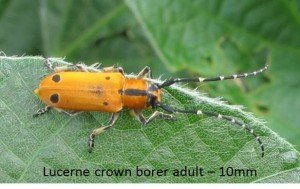The 2013/14 soybean growing season has been challenging for many growers with very low rainfall and high temperatures until late March. Crop stress was sometimes wrongly attributed to insect pests although a number of crops were infested with more unusual pests such as etiella. The high temperatures also increased the impact of lucerne crown borer in infested crops.
Etiella or Lucerne seed web moth (Etiella behri)
Etiella in vegetative crops
Etiella normally attack pods in soybean but this year they also infested vegetative crops, by attacking axilliary buds (precursors to the floral buds) before tunnelling into plant stems.
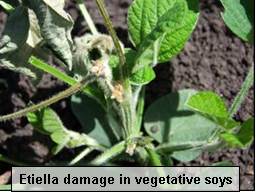
Preliminary assessment of damaged plants at the early vegetative stage suggests that yield reductions of 30% or more were incurred in heavily infested crops. While plants compensated for early stem damage by setting additional side branches, fewer harvestable pods were set per plant, and a greater percentage of pods were set too low for easy harvest (less than 10 cm above the ground).
Etiella in podding crops
When etiella infest podding crops they attack the seeds in the pods. Researchers observed that larvae generally consume only one soybean seed. This equates to a yield loss of only 0.2 grams per larva. Because large larvae consume the whole seed, harvested seed quality should not be affected in the majority of crops. The only exception would be if small larvae were still present at harvest and had only partly damaged seeds. Assuming all partly damaged seeds were carried through ( a worst case scenario), the seed quality threshold based on 2% damage is at least 40 larvae/per square metre in low-yielding crops, and double that or more (80+/m2) in high yielding crops (which contain more seeds).
Control of Etiella
There are practical issues when controlling etiella in late podfill crops. Etiella larvae enter pods through a microscopic entry hole immediately after hatching, and are usually not detected until they have inflicted considerable damage. At this stage it is unclear as to how effective pesticides are in reaching larvae inside pods. Given the very high thresholds, etiella control in podding crops would rarely be warranted in most crops in most years.
No pesticides are currently registered for etiella in summer pulses. This past season, permits were issued for chlorantraniliprole (Altacor) against etiella and bean podborer in soybean and mungbeans (PER 14592) and adzukis (PER 14586). These permits expire on 31 May 2014. Deltamethrin sprays targeting pod-sucking bugs at mid to late podfill may give some etiella protection. Note that in lentils in Southern Australia, etiella sprays target the moths.
Lucerne crown borer (Zygrita diva)
Lucerne crown borer damage
Crown borers were widely reported this summer in many soybean crops. Infestations usually occur from the early vegetative stage onwards, over an extended period of time. Eggs are inserted into stems of soybean plants and larvae tunnel up and down through the pith in the stem until they pupate, usually in the tap root. Larval feeding has little impact on yield but, prior to pupating, plants are internally ringbarked and the stem cavity is plugged above the pupal chamber. This causes plant death above the girdle and plants in thin stands may lodge before harvest. In southern Queensland and Northern NSW, this usually occurs after seeds are fully developed with little or no yield loss. In more tropical regions and in hotter summers, larval development is more rapid and there can be considerable crop losses. Larvae overwinter in the plant’s tap root, pupate in the winter, and emerge as adults in the following spring.
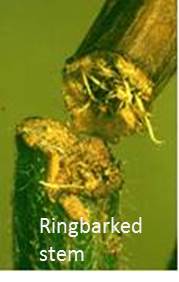
Management of crown borer
Crown borer control is difficult as larvae feed inside the stem with very little adult feeding on leaves. No pesticides are registered against crown borer in Australia.
Cultural control is one option worth pursuing.
- Avoid planting susceptible crops close to lucerne.
- In at-risk regions or paddocks, consider longer maturing cultivars
- Select paddocks with adequate soil moisture and irrigate to minimise crop stress
- In the tropics, consider winter plantings.
- Avoid thin plant stands to reduce the lodging of damaged plants
- Set harvesters up to pick up pods on lodged plants and side branches
- After harvest consider tillage to smash and bury soybean stubble. Splitting soybean tap roots destroys the crown borers overwintering refuge. Bury the tap root stubble (10 cm or more deep) to reduce adult emergence in the following spring.
- Use crop rotations to reduce the incidence of crown borer, and key diseases such as charcoal rot, phomopsis and sclerotinia.
US researchers found that their stem borer is a weak flier and more prevalent in fields where soybeans are not rotated with other crops. They also suggest the use of a perimeter trap crop such as sunflowers. While sunflowers are a reported host of crown borer in Australia, it is not known whether they are a preferred host over soybean.
Predictions of an El Nino weather pattern for the summer of 2014/15 could again mean that conditions will be favourable for both Etiella and Lucerne crown borer in soybeans.
Article by Kate Charleston and Hugh Brier

